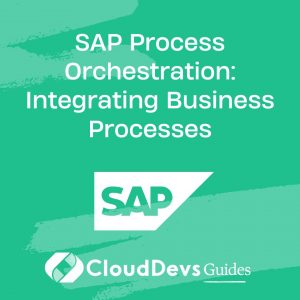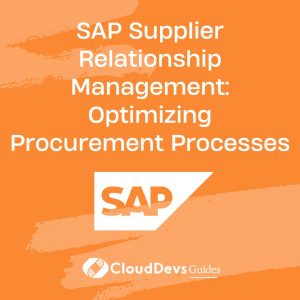SAP Process Orchestration: Integrating Business Processes
In today’s fast-paced business landscape, the ability to integrate and streamline various processes is crucial for maintaining a competitive edge. This is where SAP Process Orchestration (SAP PO) comes into play. SAP PO is a powerful tool that enables businesses to seamlessly integrate their business processes, leading to improved efficiency and productivity. In this blog, we will explore the concept of SAP Process Orchestration, its significance, and delve into practical examples with code samples to showcase its potential.

1. Understanding SAP Process Orchestration
1.1. What is SAP Process Orchestration?
SAP Process Orchestration is a comprehensive solution provided by SAP that allows organizations to integrate, automate, and optimize their business processes. It serves as a middleware tool that connects various applications, systems, and data sources, enabling them to work together seamlessly. This integration is crucial for achieving real-time data exchange and ensuring that business processes run smoothly.
1.2. Significance of SAP Process Orchestration
The significance of SAP Process Orchestration lies in its ability to address the following key business challenges:
1.2.1. Streamlined Business Processes
By integrating disparate systems and applications, SAP PO ensures that business processes are streamlined and efficient. This leads to faster decision-making, reduced operational costs, and improved customer satisfaction.
1.2.2. Real-time Data Exchange
In today’s data-driven world, real-time data exchange is essential. SAP PO enables organizations to exchange data between systems in real time, ensuring that all stakeholders have access to up-to-date information.
1.2.3. Enhanced Visibility
With SAP Process Orchestration, organizations gain greater visibility into their business processes. This enhanced visibility allows for better monitoring, reporting, and analysis, helping businesses make informed decisions.
1.2.4. Improved Compliance
Compliance with regulatory requirements is a top priority for businesses. SAP PO includes features for monitoring and enforcing compliance, reducing the risk of non-compliance issues.
1.3. Components of SAP Process Orchestration
To fully understand how SAP Process Orchestration works, let’s take a closer look at its key components:
1.3.1. Process Integration (PI)
SAP PI is responsible for facilitating the exchange of information between different systems and applications within an organization. It provides the necessary tools to create, configure, and monitor integration processes.
1.3.2. Business Process Management (BPM)
BPM allows organizations to define, execute, and monitor their business processes. It provides a graphical interface for designing and modeling processes, making it easier to manage complex workflows.
1.3.3. Business Rules Management (BRM)
BRM enables organizations to define and manage business rules. These rules can be used to automate decision-making processes within integrated systems.
1.3.4. Adapter Engine
The Adapter Engine is responsible for connecting SAP Process Orchestration with various external systems and applications. It includes a library of pre-configured adapters for different technologies and protocols.
1.3.5. Enterprise Service Repository (ESR)
ESR is a central repository for defining and managing integration objects, service interfaces, and data types. It plays a crucial role in ensuring consistency and reusability across integration projects.
2. Integrating Business Processes with SAP Process Orchestration
Now that we have a basic understanding of SAP Process Orchestration and its components, let’s explore how it can be used to integrate business processes. We will walk through a practical example using SAP PI.
Example: Order-to-Cash Process Integration
In many organizations, the order-to-cash process involves multiple systems and departments, including sales, inventory management, and finance. Integrating these processes is essential for ensuring that orders are processed efficiently, inventory levels are maintained accurately, and invoices are generated promptly.
Here’s a simplified overview of the order-to-cash process:
- Customer places an order on the company’s website.
- The order details are transmitted to the sales system.
- Inventory levels are checked to ensure product availability.
- If the product is available, an order confirmation is sent to the customer.
- Simultaneously, the order information is sent to the finance system to generate an invoice.
- The invoice is sent to the customer.
- Payment is received, and the order is marked as completed.
Let’s see how SAP Process Orchestration can be used to integrate and automate this process:
Step 1: Designing the Integration Process
In SAP PI, you can use the graphical mapping tools to define the data transformations between systems. You create mappings that convert data from one format to another, ensuring that information flows seamlessly between systems.
java // Sample SAP PI Mapping Code // Convert order data to the format required by the sales system
Step 2: Configuring Adapters
SAP PI provides pre-configured adapters for connecting to different systems. In this case, you would configure adapters for the sales system, inventory management system, and finance system.
xml
<!-- Sample SAP PI Adapter Configuration -->
<adapter-config>
<type>HTTP</type>
<address>https://sales-system.com</address>
<credentials>username:password</credentials>
</adapter-config>
Step 3: Defining Routing Rules
You can use SAP PI to define routing rules that determine how data is routed between systems. For example, incoming orders are routed to the sales system, while order information for invoicing is routed to the finance system.
xml
<!-- Sample SAP PI Routing Configuration -->
<routing-rule>
<condition>if order.type == 'online'</condition>
<target>sales-system-adapter</target>
</routing-rule>
Step 4: Monitoring and Error Handling
SAP PI provides a monitoring dashboard where you can track the status of integration processes in real time. If any errors occur during the process, you can set up automated notifications and error-handling workflows.
java // Sample SAP PI Error Handling Code // Send notification email in case of integration error
Step 5: Testing and Deployment
Before deploying the integration process into production, thorough testing is essential. SAP PI allows you to create test scenarios to ensure that data flows correctly between systems.
java // Sample SAP PI Testing Scenario // Verify data flow from order placement to invoice generation
3. Benefits of Using SAP Process Orchestration
By integrating the order-to-cash process using SAP Process Orchestration, organizations can realize several benefits:
3.1. Efficiency and Automation
Integration eliminates manual data entry and reduces the risk of errors. Automated workflows ensure that processes are executed promptly and consistently.
3.2. Real-time Updates
With SAP Process Orchestration, all stakeholders have access to real-time data, enabling them to make informed decisions and respond to customer inquiries more effectively.
3.3. Scalability
SAP PO is highly scalable, allowing organizations to adapt and grow without major disruptions to their integration architecture.
3.4. Compliance and Security
SAP PO includes robust security features and auditing capabilities to ensure data integrity and compliance with industry regulations.
Conclusion
SAP Process Orchestration is a powerful tool for integrating and optimizing business processes. It streamlines operations, enhances visibility, and enables organizations to respond quickly to changing business requirements. By automating workflows and connecting disparate systems, SAP PO empowers businesses to achieve higher efficiency and customer satisfaction.
In today’s competitive business environment, the ability to integrate and streamline processes is a strategic advantage. SAP Process Orchestration is a valuable asset for organizations seeking to stay ahead of the curve and drive innovation through seamless process integration.
If your organization is looking to enhance its business process integration capabilities, consider implementing SAP Process Orchestration to unlock new levels of efficiency and productivity.
Start your journey towards better process integration with SAP Process Orchestration today!
Remember, the success of your integration project depends on careful planning, configuration, and testing. With the right approach and the power of SAP PO, you can achieve remarkable results in optimizing your business processes.
For more information and expert guidance on SAP Process Orchestration, reach out to our team of experienced consultants. We’re here to help you harness the full potential of SAP PO for your business.
In this comprehensive blog, we’ve explored SAP Process Orchestration and its significance in integrating and optimizing business processes. We’ve also walked through a practical example of how SAP PI can be used to integrate the order-to-cash process, highlighting the benefits of using SAP PO for process integration. Whether you’re looking to streamline your operations, improve efficiency, or enhance compliance, SAP Process Orchestration can be a game-changer for your organization.
Table of Contents









